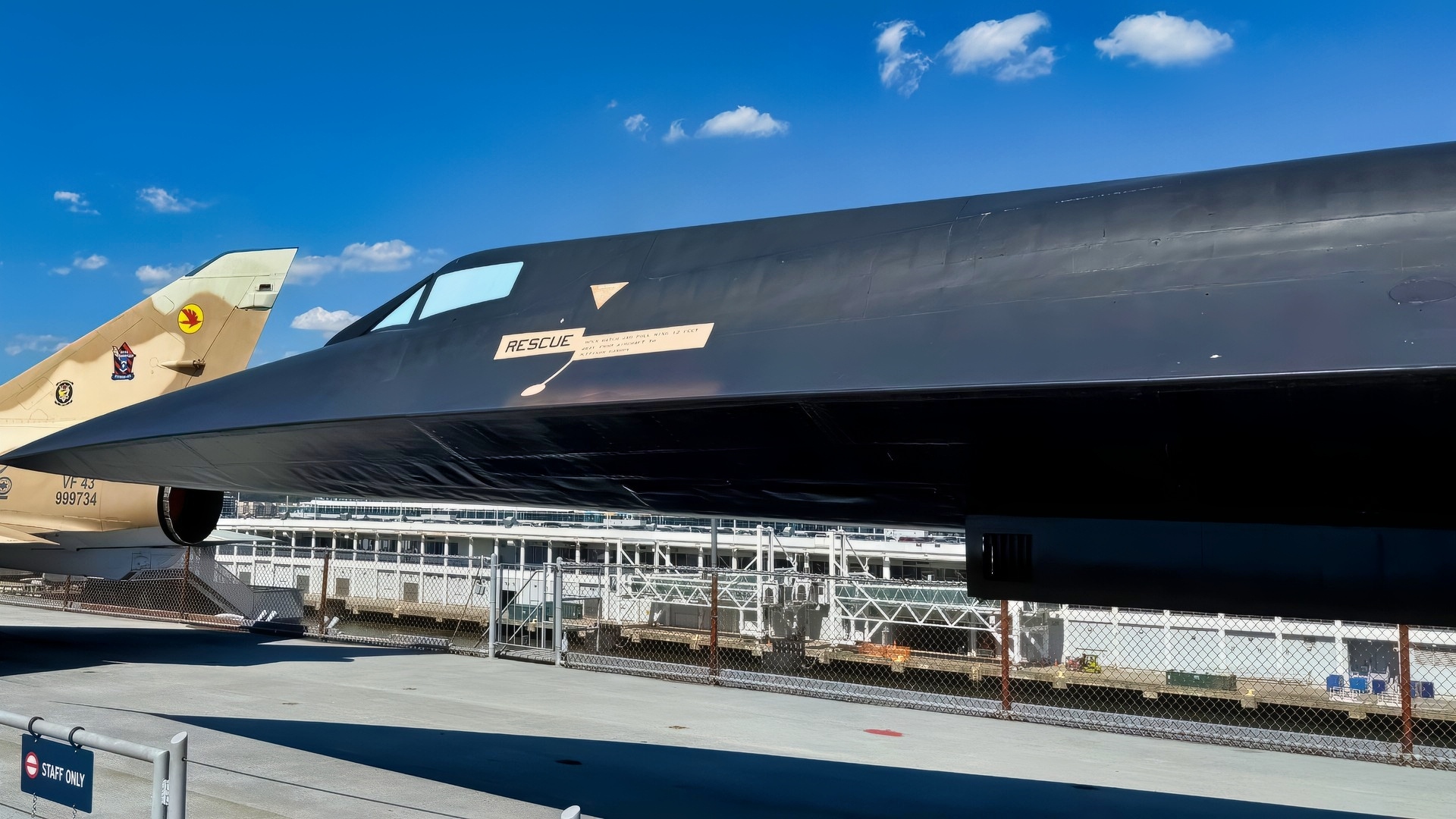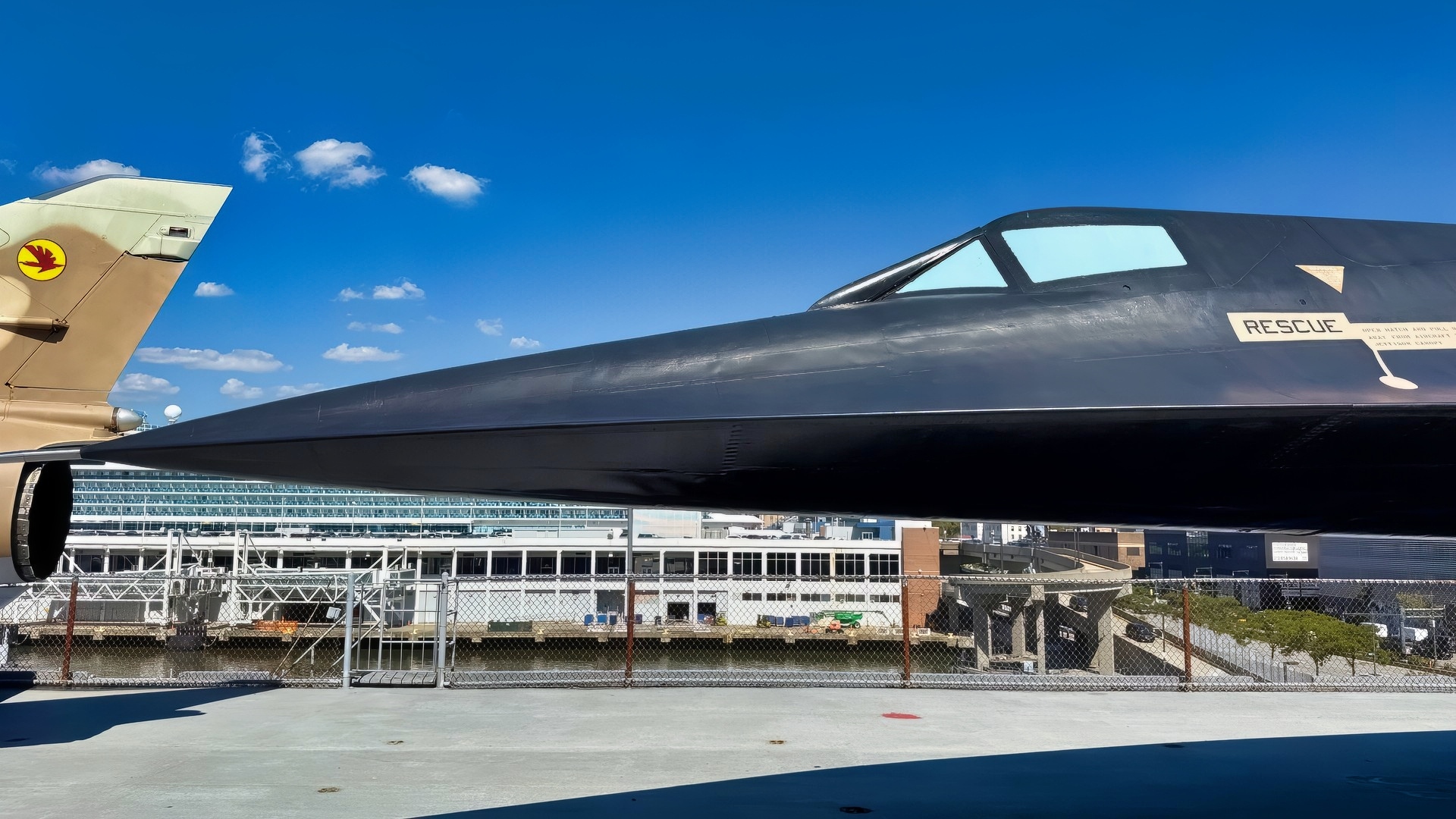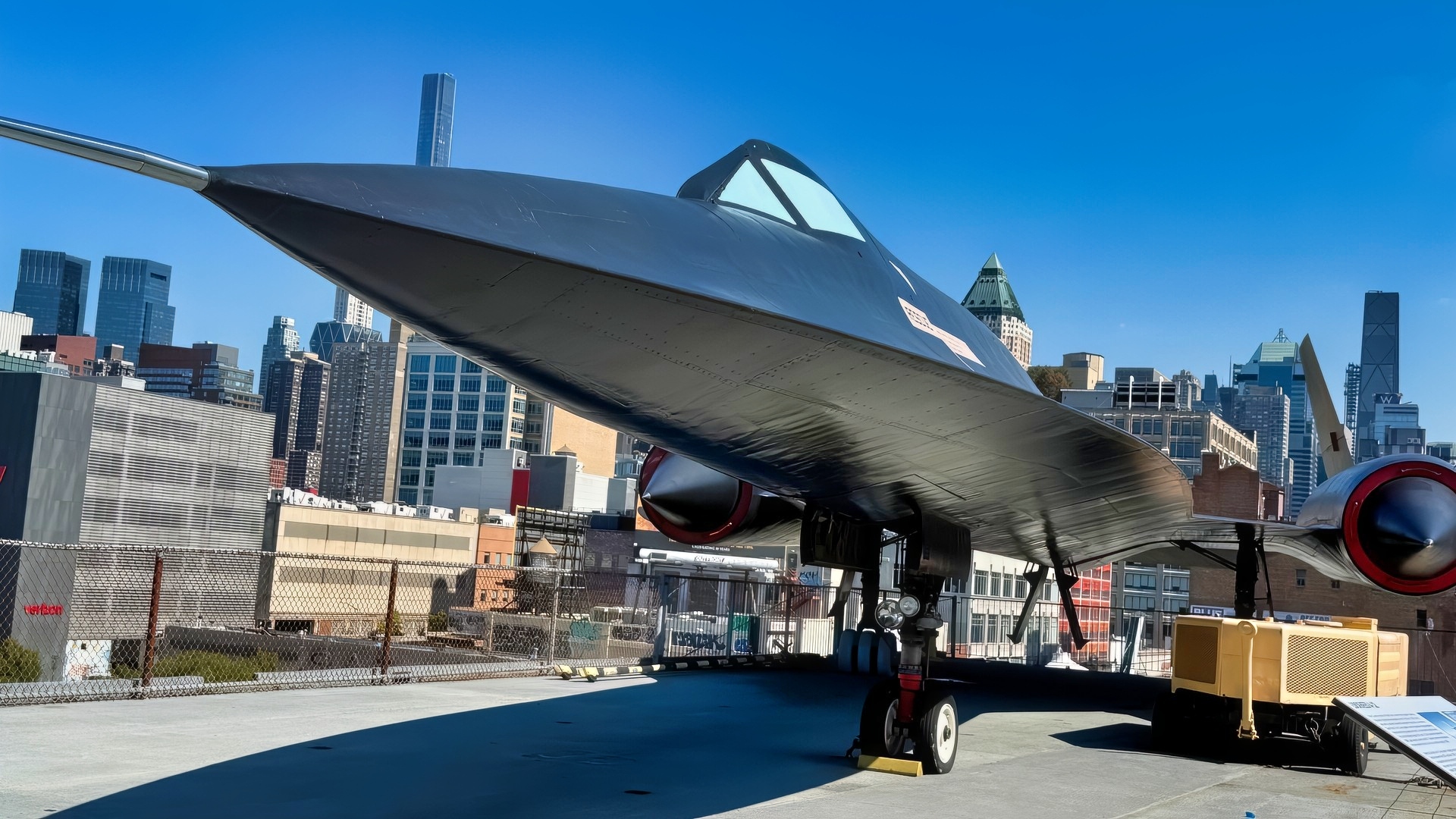Key Points and Summary – After the U-2 shootdown in 1960, the CIA needed a reconnaissance aircraft that could outrun missiles and hide from radar. Lockheed’s A-12 Oxcart answered: a single-seat, titanium spyplane that cruised above Mach 3 and around 90,000 feet.
-Developed in extreme secrecy by Skunk Works, it introduced advanced inlets, fuels, and heat-proof structures.

Lockheed A-12 from USS Intrepid. National Security Journal Photo.
-Operational in 1967 from Okinawa under Black Shield, the A-12 photographed North Vietnam and, famously, North Korea after the USS Pueblo seizure—evading multiple SAM shots.
-Retired in 1968 as the SR-71 and satellites took over, the A-12’s brief career transformed materials science, inlet control, and the art of strategic reconnaissance.
-BONUS – National Security Journal visited the Lockheed A-12 onboard the USS Intrepid in New York City. The A-12 photos from that visit are included here in this article. We also have included original photos of the SR-71 Blackbird taken at the U.S. Air Force Museum back in July.
Lockheed A-12: The Secret Mach-3 Scout That Changed The Rules
By 1960 the United States confronted a reconnaissance dilemma. Ballistic missiles and high-performance interceptors were maturing; surface-to-air missiles had made even high-flying aircraft vulnerable—as proven by the U-2 shootdown over the Soviet Union. Early photo-reconnaissance satellites were promising but weather-bound and limited in revisit and resolution. The CIA, with Pentagon support, needed imagery on demand—independent of cloud cover, fast enough to survive, and quiet enough not to trigger a war by overflight miscalculation.
The requirement hardened into three imperatives: speed (cruise past Mach 3), altitude (near the stratosphere), and low observables (reduced radar return). Only a new airframe, built from unconventional materials and powered by engines that blended turbojet and ramjet behavior, could deliver that bundle.

A-12 CIA Spy Plane. Image Credit: National Security Journal.
From Archangel To Oxcart: Designing The Impossible
Lockheed’s Skunk Works, led by Kelly Johnson, treated the project like a moonshot with a smaller budget. The design lineage—codenamed “Archangel”—iterated through multiple configurations before settling on the A-12: a long, needle-nosed fuselage, sculpted chines that both carried sensors and reduced radar cross-section, twin canted fins, and variable-geometry inlets with translating spikes and bleed doors to tame supersonic airflow.
Building the aircraft was as radical as shaping it:
Titanium Everywhere. Aluminum softened in the A-12’s skin temperatures. Skunk Works built the structure largely of titanium, inventing new tools, fasteners, lubricants, and welding techniques. Even cadmium-plated shop tools had to be abandoned—they contaminated the metal.
Heat As A Design Driver. At cruise, aerodynamic heating baked the airframe. Panels grew and shifted; the airplane leaked fuel on the ramp and sealed itself only after warming in flight.
Engines And Fuel. Purpose-built J58 engines were optimized for extreme speeds; their afterburners doubled as part of a quasi-ramjet cycle at high Mach. The aircraft burned JP-7, a thermally stable fuel that also served as coolant and hydraulic working fluid. Ignitions and relights used triethylborane, a green-flashing, pyrophoric spark in a bottle.
Secrecy By Geography. Testing moved to a remote Nevada site—Groom Lake—under the cover name OXCART. A handpicked cadre of test pilots learned to manage a new phenomenon, the “unstart,” when an inlet swallowed shockwaves and the airplane yawed violently until systems recovered.
First flight came in 1962; the program spent years taming inlet controls, refining fuel systems, and proving that structure and systems could survive long, hot dashes without tearing themselves apart.
Rolling Into The Shadows: Training, Basing, Cameras
Unlike the later two-seat SR-71, the A-12 was single-seat. Pilots shouldered navigation, sensors, and aircraft management with ground teams and tankers as lifelines. The optical payloads lived in bays along the chines and in the nose—ultra-long-focal-length cameras fed by precise stabilization and temperature control. The aircraft’s operational concept depended on KC-135Q–type tankers and meticulously planned tracks; a single mission might involve multiple refuelings, climbing to cruise only when the jet and the sky were ready.
By 1966–67, the CIA declared the airplane fit for deployment. A secure detachment stood up at Kadena Air Base, Okinawa: hardened shelters, highly trained maintainers, and tanker support formed a miniature, portable reconnaissance ecosystem.
Black Shield: The A-12 At War’s Edge
Operational sorties, under the codename BLACK SHIELD, began in 1967 over North Vietnam. The A-12’s job was to image SAM sites, logistics nodes, and airfields—to feed the targeting cycle and to measure how quickly the defenses were rebuilding after U.S. strikes. Enemy radars tracked the airplane; SAMs were fired; none hit. The Oxcart simply outran the threat, turning slightly to spoil missile kinematics and trusting altitude, speed, and tactics.
In January 1968, after North Korea seized the USS Pueblo, the A-12 made emergency runs over the peninsula and approaches, producing time-critical imagery that helped Washington understand where the ship had been moved and how defenses were postured. Again, the flights were brief, supersonic, and deniable enough to avoid immediate escalation.
Across its short operational span, the detachment flew a modest number of missions—each one a high-stakes sprint that married exquisite planning with an airplane at the edge of materials science.
Accidents, Losses, And The Learning Curve
A program this ambitious paid tuition in blood and money:
Test And Training Crashes. Several A-12s were lost during the Nevada test phase and crew workups; one pilot survived ejection only to die when his seat failed to separate from the chute—an agonizing reminder that small systems matter at Mach-class programs.
The Drone Variant. A specialized A-12 derivative, the M-21, carried a high-speed D-21 reconnaissance drone on its back. In 1966 a separation mishap broke the aircraft; the pilot survived, but the launch-control officer was lost at sea. The concept later shifted to B-52 launches; the M-21 effort ended.
Unstarts And Inlet Taming. Crews learned to anticipate and ride out inlet unstarts—rapid yaw and deceleration when a shockwave migrated and the inlet gulped subsonic flow. Engineers eventually refined automatic controls to catch and correct the problem faster than human hands could.
Nothing about Oxcart was routine. Every fix—stronger valves, better seals, smarter inlet logic—reverberated across later high-speed aircraft.
Why The A-12 Was Retired So Quickly
For all its brilliance, the A-12 found itself boxed in by politics, budgets, and cousins:
One Family, Two Owners. The Air Force backed the SR-71, a two-seater with greater range and payload flexibility; the CIA owned the A-12. Running two near-identical fleets was expensive and inefficient.

SR-71 and SR-71 Nose Section Original Photo from NSJ.

SR-71 Side Angle National Security Journal Original Photo.

SR-71 National Security Journal Image.
Satellites Grew Up. By the late 1960s, space systems were delivering predictable coverage with improving resolution—and zero risk of creating an international incident by violating sovereign airspace.
Cost And Complexity. Each A-12 sortie consumed a convoy of tankers, specialized fuels, and rare materials. The program’s per-mission price was defensible in emergencies, but not as the everyday backbone of reconnaissance.
In 1968 the A-12 detachment at Kadena stood down. Airframes flew to storage and secrecy held for years. The SR-71 soldiered on in Air Force colors; the CIA left the manned high-speed game.
What The Program Changed—Forever
Even with a brief frontline career, Oxcart’s fingerprints are everywhere in aerospace:
Materials Science. The industrial base learned to machine, weld, and coat titanium at scale, knowledge that bled into later aircraft and even non-aerospace industries.
Inlet And Propulsion Control. Managing shockwaves and bleed at Mach 3+ became a discipline, informing everything from later Blackbirds to the way engineers think about hypersonic inlets now.
Thermal Management. Using fuel as coolant, designing for expansion, and treating heat as a first-order variable all matured under Oxcart’s pressure.
Low Observables Before “Stealth.” The A-12 wasn’t invisible, but its shaping, chines, and edge alignment deliberately trimmed radar return—an early, pragmatic step toward what would later become a formal stealth design philosophy.
Tradecraft And Integration. Oxcart linked human pilots, satellites, tankers, analysts, and policy in near-real time. That “sensor-to-decision” loop—fast collection, faster exploitation—became the national reconnaissance habit.
The Public Epilogue: Museums And Memory
When the veil lifted, A-12s emerged from storage to museum decks and lawns: a few sit near test sites and bases; one perches dramatically on a Manhattan pier alongside a WWII carrier (we know, we were just there)—silent, sharp, black.
They’re not merely artifacts; they’re lesson plans in metallurgy, risk, and the costs a democracy will bear to see over the horizon.
Final Appraisal: Short Life, Outsized Legacy
The Lockheed A-12 was the right airplane for a narrow window—when satellites couldn’t always see, when the world’s most lethal air defenses were just good enough to demand something extraordinary, and when a handful of pilots were willing to strap into a machine that ran on heat and math. Its successor, the SR-71, flew longer; satellites ultimately did more. But Oxcart proved the physics, wrote the procedures, and taught a generation how to think about speed, temperature, and survivability as a single problem.

SR-71 Blackbird Spy Plane Back in 2022. Image Credit: National Security Journal/Harry J. Kazianis.
In that sense, the A-12’s legacy is larger than its sortie count. It turned fear—of-missiles, of clouds, of surprise—into a design. And for a few intense years, that design gave the United States the fastest camera in history.
About the Author: Harry J. Kazianis
Harry J. Kazianis (@Grecianformula) is Editor-In-Chief and President of National Security Journal. He was the former Senior Director of National Security Affairs at the Center for the National Interest (CFTNI), a foreign policy think tank founded by Richard Nixon based in Washington, DC. Harry has over a decade of experience in think tanks and national security publishing. His ideas have been published in the NY Times, The Washington Post, The Wall Street Journal, CNN, and many other outlets worldwide. He has held positions at CSIS, the Heritage Foundation, the University of Nottingham, and several other institutions related to national security research and studies. He is the former Executive Editor of the National Interest and the Diplomat. He holds a Master’s degree focusing on international affairs from Harvard University.
More Military
The A-6 Intruder Has a Message for the U.S. Navy
USS Intrepid (CV-11) Has a Message for the U.S. Navy
F-16XL Was the Plane the Air Force Wouldn’t Fly
NATO-Russia War of 2025: It Won’t Be Pretty
K3: The ‘Stealth’ Tank That Looks Like a B-21 Raider and Runs on Hydrogen










